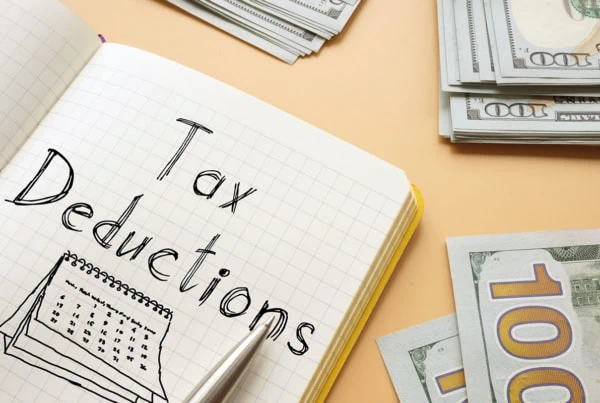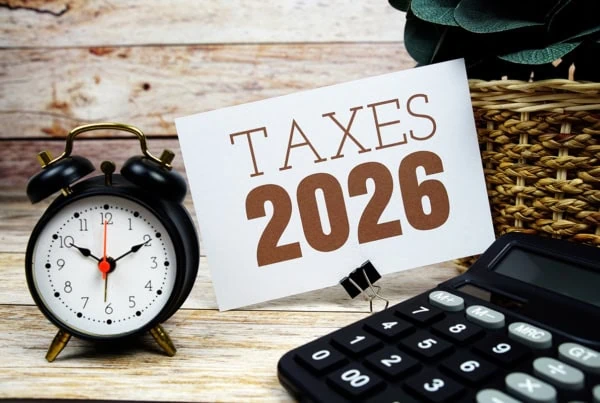Aging has its benefits. Many people find that as they become older, they become wiser, more resilient, and have developed deeper relationships.
There are a few financial perks, too. Eventually, you can start collecting Social Security, make penalty-free withdrawals from your retirement accounts … and, over time, pick up a few tax benefits.
Some tax perks begin as young age 50, though some don’t kick in until you’ve reached your 70s. Regardless, you’ve worked hard for decades, so you deserve to start reaping some of the rewards once you get older.
Read on as we highlight several tax breaks that are specifically for older adults.
Age-Based Tax Benefits

Older adults can qualify for these tax advantages based just on their age—you don’t need to be below a certain income threshold or have a disability.
The age you become eligible for each of these tax benefits ranges from age 50 to 70 ½, so the older you are, the more money you could potentially save.
There is no reason to miss out on these benefits if you qualify.
1. Additional Standard Deduction

If you’re at least 65 years old, you automatically qualify for an additional standard deduction, which can be tacked right onto your regular standard deduction.
The additional standard deduction for the 2025 tax year is $1,600 (up from $1,550 in 2024) per qualifying individual for married couples filing jointly, married taxpayers filing separately, and surviving spouses; that figure is $2,000 (up from $1,950 in 2024) for single and head-of-household filers.
Also, if you are age 65 or older and blind, your additional standard deduction is doubled. Thus, your additional standard deduction for the 2025 tax year would be $3,200 (up from $3,100 for 2024) per qualifying individual if your status is married filing jointly, married filing separately, or surviving spouse; and $4,000 (up from $3,900 for 2024) if you filed as single or head of household.
Related: What Is the Standard Deduction?
2. Senior Deduction

The passage of the 2025 budget reconciliation bill also ushered in a new (albeit temporary) Senior Deduction.
To qualify for the Senior Deduction, you must turn 65 within the tax year you want to claim it, you must have a Social Security number (an individual taxpayer identification number, or ITIN, is not enough), and if you’re married, you must file a joint return. You can take the Senior Deduction regardless of whether you itemize or take the standard deduction, and you can take it in addition to the additional standard deduction.
All qualified seniors start with a $6,000 deduction. If you’re married and filing a joint return, both you and your spouse start with a $6,000 deduction, for a total of $12,000. However, if your “modified adjusted gross income” (MAGI) is more than $75,000 ($150,000 if you’re filing a joint return), then your $6,000 deduction is reduced by 6¢ for every dollar of MAGI over the applicable threshold. The $6,000 deduction is reduced all the way to $0 when your MAGI reaches $175,000 ($250,000 for joint filers).
For purposes of this deduction, MAGI is equal to the adjusted gross income reported on your tax return, plus any:
- foreign earned income or housing excluded from taxation
- income excluded from taxation for residents of Guam, American Samoa, the Northern Mariana Islands, or Puerto Rico
Example: Suzanne is 80 years old and single. Her MAGI for the year is $90,000, which is $15,000 over the phase-out threshold for single taxpayers ($90,000 – $75,000 = $15,000). As a result, her deduction is reduced by $900 ($15,000 x .06 = $900). So, her Senior Deduction for the year is $5,100 ($6,000 – $900 = $5,100).
Just note that the Senior Deduction is temporary: Per the reconciliation bill, it is only available between the 2025 and 2028 tax years.
Related: When and How to Adjust Your Tax Withholding
3. Most States Don’t Tax Social Security Benefits

At the federal level, your Social Security benefits are generally taxable. This is true whether you receive retirement, survivor, or disability benefits from the Social Security Administration. However, you don’t have to pay federal income taxes on Social Security payments if your combined income is below a certain amount. (We cover all the pertinent details in our article discussing how Social Security benefits are taxed.)
The same isn’t always the case at the state level. In fact, 41 states do not tax Social Security benefits, and the needle is pointed in the right direction. That 41 includes two states—Missouri and Nebraska—that halted Social Security taxes in 2024. And one of the current nine remaining states that do tax Social Security (West Virginia) passed a law that will phase out the tax by 2026.
So, if you’re planning a move in retirement, make sure to consult this list of states that tax Social Security benefits before you finalize your decision. While taxation of your Social Security benefits shouldn’t necessarily be the sole deciding factor, if you’re torn between two or more states as different retirement landing spots, this might help you lean one way or the other.
Related: 11 Ways to Avoid Taxes on Social Security Benefits
4. Free Tax Counseling and Filing Assistance

No matter your age, doing your taxes can be overwhelming. Roughly half (53%) of Americans say the complexity of the federal tax code “bothers them a lot,” according to a Pew Research Center survey.
Fortunately, individuals ages 60 and older can get free tax counseling and filing assistance through the Tax Counseling for the Elderly (TCE) grant program.
Qualified volunteers, who have taken and passed tax law training that meets or exceeds IRS standards, provide “efficient and quality tax assistance” year-round. They also provide tax return preparation assistance during the normal federal filing period (Jan. 1 through April 15) each year.
As an added layer of caution, every return prepared by TCE volunteers undergoes a quality review before it’s filed.
Related: How to Choose a Financial Advisor
5. Employer-Sponsored Retirement Plan Catch-Up Contributions

Employer-sponsored retirement plans are an excellent way to save for retirement. They sport tax advantages, and many employers also offer matching contributions (up to a certain percentage or dollar amount). There’s a limit to how much you can contribute in a given year, but if you are age 50 or older, you can make an additional $7,500 in annual “catch-up contributions” to the following plans:
- 401(k) (excluding a SIMPLE 401(k))
- 403(b)
- SARSEP
- Governmental 457(b)
The 2025 contribution limit for employees with a 401(k) or equivalent account is $23,500, up from $23,000 in 2024. The catch-up contribution amount for 2025 is an additional $7,500, for a total of $31,000 (2025). (Note: Elective deferrals aren’t treated as catch-up contributions until they exceed the contribution limit.)
But a fortuitous twist was added starting in 2025: Individuals ages 60 to 63 are allowed a higher catch-up contribution amount of $11,250.
Retirement plans can substantially grow your money over time, so in general, the closer you can get to maxing out one of these plans, the better.
Related: Saver’s Credit: What Is It, How Much, Who’s Eligible + More
6. IRA Catch-Up Contributions

Individual retirement accounts (IRAs) and Roth IRAs benefit from a similar rule.
IRAs have a number of limitations. The straight-line 2025 IRA contribution limit is $7,000 (same as 2024), but individuals age 50 and older may make an additional $1,000 in IRA catch-up contributions, for a total of $8,000. Importantly, IRA contribution limits apply toward all IRAs you might have—in other words, you can’t contribute $7,000 to each of five different IRAs and/or Roth IRAs, but $7,000 across all five IRAs and/or Roth IRAs.
However, people also may only contribute up to their taxable income in a given year, so if you make less than the straight-line contribution limit (say, $5,000), you can only contribute up to what you made.
Also, if you have a Roth IRA, your income may also limit your ability to contribute.
You can contribute to a Roth IRA, up to the straight-line 2025 IRA contribution limit, if you are:
- Single, head of household, or married filing separately (but you didn’t live with your spouse at any time in 2025) with MAGI of less than $150,000 (up from $146,000 in 2024)
- Married filing jointly or qualifying surviving spouse with MAGI of less than $236,000 (up from $230,000 in 2024)
You can only make a partial contribution to a Roth IRA if you are:
- Single, head of household, or married filing separately (but you didn’t live with your spouse at any time in 2024) with MAGI of at least $150,000 but less than $165,000 ($146,000 but less than $161,000 for 2024)
- Married filing jointly or a qualifying surviving spouse with MAGI of at least $236,000 to $246,000 ($230,000 but less than $240,000 for 2024)
- Married filing separately with MAGI of less than $10,000
You can’t contribute to a Roth IRA if you are:
- Single, head of household, or married filing separately (but you didn’t live with your spouse at any time in 2025) with MAGI of or more $165,000 ($161,000 for 2024)
- Married filing jointly or a qualifying surviving spouse with MAGI of $246,000 or more ($240,000 for 2024)
- Married filing separately with MAGI of $10,000 or more
You can get more detail in our article on IRA contribution limits.
Related: What Is a Roth Conversion? [A Tax-Smart Retirement Strategy]
7. Health Savings Account Catch-Up Contributions

Health savings accounts (HSAs) are an incredible way to save for qualified health care expenses; however, some people actually use HSAs as supplemental retirement accounts.
HSAs have a lower contribution limit than a 401(k) or IRA. For 2025, the limit is $4,300 for individuals (up from $4,150 in 2024) and $8,550 for family coverage (up from $8,300 in 2024).
The age when you become eligible for HSA catch-up contributions is different as well. Individuals can contribute an additional $1,000 annually in 2024 and 2025, but beginning at age 55, not age 50 like with 401(k)s and IRAs.
Remember: Only people enrolled in eligible high-deductible health plans (HDHPs) can contribute to these accounts.
Related: HSA Rollover: How to Transfer HSA Funds to a New Provider
8. Qualified Charitable Distributions

This tax trick is for individuals who are at least 70½ years old.
If you are age 70½ or older, you can make a qualified charitable distribution (QCD)—also known as IRA charitable distribution or IRA charitable rollover—from your IRA to a charity, then exclude that amount from your gross income. The QCD limit for 2025 is $108,000 for individuals (up from $105,000 in 2024), or $108,000 for each spouse up to $216,000 for a married couple.
This break may help donors avoid reaching a higher income bracket, which in turn may prevent the phase-out of different tax deductions, such as personal exemption and itemized deductions.
QCDs have another advantage.
People with individual retirement accounts (IRAs) typically must take required minimum distributions (RMDs) beginning at age 72 (or 73 if you reach age 72 after Dec. 31, 2022). These RMDs increase an individual’s total taxable income. However, once you reach age 72 (or 73), QCDs can count against your RMDs for the year.
Just note that QCDs must be made directly from the IRA, whether that’s electronically, directly to the charity, or by check payable to the charity. Also, donations can be made only to certain qualified charitable organizations, which are defined in the tax code.
Related: American Opportunity Tax Credit: Eligibility, Amount + More
9. 14 Days of Tax-Free Rental Income

If you’ve ever thought about renting out your residence for a very short period of time while you’re out of the house, you might not need to report the income on your tax return.
You can thank the residents of Augusta, Georgia, in the 1970s for this tax quirk.
Nicknamed “The Augusta Rule” on account of the people who own and rent out their homes near the Augusta National Golf Club during the annual Master’s Golf Tournament that’s held there, this special income exclusion lets you exclude any rental income that comes from renting your residence for two weeks or less. (However, be aware that if you use the rule to exclude income, you will not be able to deduct any associated rental property expenses.)
So, if you have short-term rental demand for your residence and a desire to have guests pay to use it, you might be able to tap into this tax loophole.
Technically, anyone can use this “rule.” However, older adults are more likely to both have a home as well as flexibility around when they’re able to temporarily leave the home and rent it out.
Related:







![What’s Your Capital Gains Tax Rate? [2025 + 2026] 24 whats your capital gains tax rate](https://youngandtheinvested.com/wp-content/uploads/whats-your-capital-gains-tax-rate-600x403.webp)
